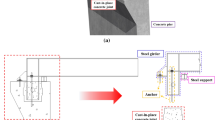Abstract
This study presents new steel girder bridge system. The main feature of the proposed bridge is the construction of steel I-girders and inverted-T bent caps at the same elevation. Thus, the proposed bridge system eliminates huge bent cap in traditional girder bridge and provides more space under the bridge. In this system, the composite behavior of the joint is the key to ensure structural performance. Two methods for connecting steel girders and bent caps are examined, including the introduction of prestressing forces and installation of steel plates. In order to make sure the performance of aforementioned methods, the key part of full-scale bridge was fabricated and tested. A finite element model were also developed and verified with the full-scale test. In addition, parametric studies were conducted to investigate the effect of prestressing force and thickness of steel plate on the behavior of the test unit by means of nonlinear finite element analyses.
Similar content being viewed by others
References
AASHTO (2010). AASHTO LRFD Bridge Specification. 5th ed., American Association of State Highway and Transportation officials, Washington D.C.
ABAQUS (2007). ABAQUS/Standard User’s Manual. Version 6.71, ABAQUS, Inc., Pawtucket, R.I.
Baskar, K., Shanmugam, N. E., and Thevendran, V. (2002). “Finite-element analysis of steel-concrete composite plate girder.” Journal of Bridge Engineering, 128(9), pp 1158–1168.
Chu, W., Salmon, G., and Pincheira, A. (2007). Reinforced concrete design. 7th ed., John Wiley & Sons, Inc., pp. 173–175.
Chung, W. and Sotelino, E. D. (2006). “Three-dimensional finite element modeling of composite girder bridges.” Engineering Structures, 28(1), pp. 63–71.
Chung, W., Jung, D., and Kim, S. (2013). “Strength and behavior of a vertically pre-tensioned composite rigid frame bridge.” International Journal of Steel Structures, 13(2), pp. 367–378.
Dunai, L. (2004). “Experimental and numerical studies on the cyclic behavior of steel and composite joints.” International Journal of Steel Structures, 4(4), pp. 197–208.
Furlong, R. W., Ferguson, P. M., and Ma, J. S. (1971). Shear and anchorage study of reinforcement in inverted T-beam bent cap girders. Res. Rep. 113-4, Center for Highway Research the University of Texas at Austin.
Galai, K. and Sekar, M. (2008). “Rehabilitation of RC inverted-T girders using anchored CFRP sheets.” Composites: Part B, 39(4), pp. 604–617.
Guezouli, S., Somja, H., Kaing, S., and Lachal, A. (2011). “Numerical modelling of composite beam-to-beam joints-innovative solutions.” Composite Construction in Steel and Concrete VI, pp. 542–553.
KBDS (2012). Korea Bridge Design Specification. Ministry of Land, Infrastructure and Transport, Sejong City, Korea (in Korean).
Kim, S. H., Yoon, J. H., Kim, J. H., Choi, W. J., and Ahn, J. H. (2012). “Structural details of steel girder-abutment joints in integral bridges: An experimental study.” Journal of Constructional Steel Research, 70, pp 190–212.
Kim, T. H., Kim, Y. J., Lee, J. H., and Shin, H. M. (2010). “Precast concrete copings for precast segmental PSC bridge columns: II. Experiments and analyses.” Journal of the Korean Society of Civil Engineers, 30(5), pp 475–484.
Lee, J. and Fenves, G. (1998). “Plastic-damage model for cyclic loading of concrete structures.” Journal of Engineering Mechanics, 124(8), pp. 892–900.
Lubliner, J., Oliver, J., Oller, S., and Oñate, E. (1989). “A Plastic-damage model for concrete.” International Journal of Solids and Structures, 25(3), pp. 229–326.
Somja, H., Kaing, S., and Lachal, A. (2012). “New beam-tobeam joint with concrete embedding for composite bridges experimental study and finite element modeling.” Journal of Constructional Steel Research, 77, pp. 210–222.
Song, G., Gu, H., Mo, Y. L., Hsu, T. T., and Dhonde, H. (2007). “Concrete structural health monitoring using embedded piezoceramic transducers.” Smart Materials and Structures, 16, pp. 959–968.
Synder, R. (2010). Seismic performance of an I-girder to inverted-T bent cap bridge connection. Master of Science Thesis, Iowa State University, Ames, Iowa, USA.
Zhu, R. R. H., Dhonde, H., and Hsu, T. T. C. (2005). “Crack width prediction for ledges in inverted ‘T’ bent caps.” American Concrete Institute Special Publication, 225, pp 179–196.
Author information
Authors and Affiliations
Corresponding author
Additional information
Discussion open until May 1, 2015. This manuscript for this paper was submitted for review and possible publication on February 26, 2014; approved on December 1, 2014.
Rights and permissions
About this article
Cite this article
Lee, H., Cho, D., An, Z. et al. Composite behavior of steel I-girders connected to inverted-T bent cap. Int J Steel Struct 14, 711–721 (2014). https://doi.org/10.1007/s13296-014-1203-1
Published:
Issue Date:
DOI: https://doi.org/10.1007/s13296-014-1203-1




